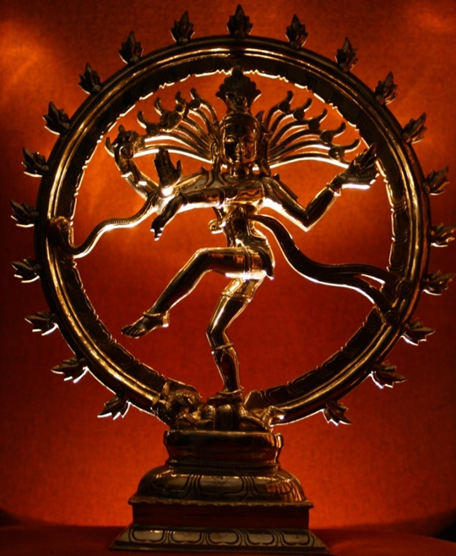At our first stop at Thanjavur, we saw the immense Brihadeeswaran Kovil (Temple of
Brihadeeshwara). This is one of the largest temples in India, is approx 1000 years old, built by Raja Raja Chola and is dedicated to Shiva. The Vimana (tower above the temple) is so tall (200 + ft) and is carved of a single piece of rock and to achieve this, a ramp was built measuring about 7 kilometres long and the rock was hauled by elephants and placed at its present location!! The lord of the temple is Shiva in the form an enormous Linga.
The next day that
we were to travel to Chidambaram, Taruni fell very ill with a painful catch in
her neck and we had to abandon all our plans. Aparna managed a trip to Swami
Malai, a nearby hillock with a temple, where the bronzes are actually cast and
carved, however, was unable to procure any and came back disappointed. We had
just one more day to visit Chidambaram since our train tickets were booked for
the next night out of Kumbakonam to Trichy. There is a story about Chidambaram
and Nataraja which is intriguing and compelling about the magic and mystique of
Shiva. The area around Chidambaram has mangroves which were known as the
forests of Thillai.
Aeons before, in the forests of Thilllai lived Sadhus and Rishis. These learned men had gone wayward and started believing themselves to be as, if not more powerful, than the gods themselves. To teach them a lesson, Shiva descended to Thillai as a Bhikshathan (mendicant)
along with Vishnu in the form of Mohini an enchantress. Shiva plays his drum or the Damaru and Mohini dances sensuously to the rhythms. The Sadhus and their women folk are captivated by this music and dance and follow the couple in a trance into the forests. Suddenly, the Sadhus are angered at this, especially their women folk being led away and hurl magical curses at Shiva. The snake that they cast at him, he wears it as an ornament around his neck, a tiger that attacks him, he skins with his little finger and wraps its skin around his waist and a demon they set onto him, he tramples and vanquishes as he dances the Ananda Tandava (the dance of bliss) and reveals his true self. It is believed that Chidambaram was the centre of the universe and is home to the famous “Chidambara Rahasyam” or “Chidambaram’s Secret”.The next day,
Taruni was a lot better and to help her, we upgraded ourselves from an
Ambassador to an Innova as our taxi and started off to Chidambaram at a
leisurely time. Enroute was a temple famous for its curative powers and we
perforce had to “Matha theko” there as well. So, by the time we arrived at
Chidambaram at 1 p.m., the culmination of our enchantment with Shiva, it was
siesta time. What we didn’t realize was that the temples in Tamil Nadu closed
at about 12ish and opened around 4:30-5. And our train (from Kumbakonam, more
than 2 hrs away) was at around 8 p.m. Our plan had been, to experience the
magic of Shiva at Chidambaram, drive to Kumbakonam and shop for a bronze
Nataraja and then catch the train. And now, with the temple closed, we had time
enough for only one. It was indeed a test of our resolve, of which to choose,
and I am glad the spiritual won victory over the materialistic side. We had
travelled this far, to the centre of the universe, to feel the rhythm of
existence. We could always pick up a Nataraja anywhere, even in Bangalore.
Right?
So, we spent a wonderful and unhurried few hours in and around the temple and saw the intricately carved Ratha or chariot in which God is perambulated around the temple. The paths surrounding the temple, where the chariot is pulled by the faithful are called the North, South,
East and West Car streets. Taruni also delighted us with her version of the Nataraja pose as we waited for the doors to open. While we waited, we were told the story of how Shiva cheated to win the title of the greatest dancer. It seems, Shiva and Parvati had a competition as to who was the better dancer and for every movement of Shiva, Parvati was able to match it step for step. Realizing that he wouldn’t be able to better her without cheating, he adopted a pose where he raised his right leg completely vertical, straight up as he stood on his left. Parvati, realizes that this is a very un-lady like pose and refrains and concedes to Shiva.The darshana of
Shiva was very beautiful, in the form of Nataraja and it only evoked a twinge
of disappointment in our hearts that we wouldn’t be carrying him home. Adjacent
to the main sanctum sanctorum is a small mantapa which is covered by a richly
embellished curtain. It hides within it, the Chidambara Rahasyam. We waited
with bated breath to see what wonderment was hidden inside as the Pujari
dramatically drew the curtain aside.
And there was
“nothing”. I mean absolutely nothing. It was then that it was explained to us,
that the Rahasyam or the secret is that, what we see is Maya or an illusion and
God and the universe exists within us. I think it needs enlightenment to
realize rather than understand this.
Immediately after
the darshana, we sped back to Kumbakonam, afraid that we would miss our train.
As luck would have it, the traffic was light and the driver was fast and we
were back at Kumbakonam with about 30 minutes to spare. A hope was sparked in
us, though the light was fading, as we enquired with the driver if there were
any sellers of bronzes nearby, at this hour. He took us to the precincts of one
of the temples, on the outer side of which seemed to be a few ramshackle shops
with some 4 ft figurines in the
making. The first shop seemed to
specialize in large sizes, the second didn’t have any Natarajas ready and
neither did the third of the size we needed. Feeling extremely disappointed, I
was about to leave, when I spied a Nataraja on the top most shelf, in the dark
recesses of the shop, but it seemed to be black in colour. When I asked for it,
he seemed a little hesitant and said that it had been around for a long time.
My hands trembled
as I tried to wipe the soot and grime away. I couldn’t see the metal, it was so
coated with grime and cobwebs, but the features seemed to be angular and clean
as Chola bronzes are. I couldn’t even ask Aparna for a second opinion since she
was in the car with Taruni on her lap, fast asleep. I turned to the shop keeper
and he said 8000 rupees. This was way above our budget of 3-4000. And I didn’t
have time to bargain. I quickly pulled out my purse and checked, I had about
5000 rupees. I decided to keep 500 rupees aside and made an offer of 4500. The
owner refused outright but quoted 6000. I was desperate and running out of
time, so I offered the entire 5000 and said that’s all I had and either he
agreed or didn’t, since I had to catch a train. He wavered for a moment and
grumbled that it was too less, so I said sorry and started moving away. He
called me back and said “fine OK”. My heart took a leap as I thrust all the
money into his hand and asked him to quickly pack it.
One of the helpers
pulled out a piece of cloth and some liquid and started to polish it. I told
him to stop and just pack it. He looked a little bewildered, but wrapped it in
newspaper and put it into a box. I quickly carried it to the car and we set
course towards the railway station.
Aparna asked me “how does it look” and I frankly said, “I don’t know,
but I think it is good”. Just short of the railway station, we stopped at the
ATM because I had absolutely no money and we hadn’t paid for the taxi yet. We
reached the station with a few minutes to spare. Once inside the compartment,
we opened the box and examined the Nataraja.
It was black,
except the part where the worker had wiped off a bit of the grime where it was
a dull but warm pinkish colour. We dropped a few drops of oil on a hand
kerchief and started scrubbing at the grime. Slowly emerged a beautiful figure,
the features were sharp and angular, the expression peaceful, with a hint of a
smile. The body was sinewy yet lithe, even the slight bulge of the calf muscle
was sculpted well. The tiger skin around the waist, the anklets, the damaru
signifying the rhythm of the universe, the fire in his left hand signifying
destruction, the stubby demon at his foot, Apasmara Purusha signifying
ignorance and the act of it being vanquished by Shiva, the cosmic dancer
surrounded by the aureole of flames which represents the universe…































